| Comments on the paper by Keller et al 2004, "More evidence that the Chicxulub impact predates the K/T mass extinction", Meteoritics and Planetary science MAPS, vol. 39. p.1127-1144, And on the paper by Stinnesbeck et al (2004), International Journal of Earth Sciences (Geologische Rundschau) (available Online) (or here) | Quotes from Keller in pink, | |||||||||||||||||||||||||
|
Discussed items Comment in yellow |
 |
Items i-iv have repeatedly shown to be invalid and seriously flawed
i) Proves nothing. Why should a several m thick sandstone be inconsistent with a K/T age for the Chicxulub tektites? ii) Flawed conclusion. The stackied (tiered) burrowed horizons at the top sandstone layers of the sandstone are easily explained by colonization of the ocean floor after the tsunami action in the Gulf of Mexico was over. iii) The iridium anomaly is within the clastic sandstone, mostly in the graded silty beds at the top. Iridium is thus deposited in the settling phase of the tsunamiwave disturbances ('K/T boundary cocktail"), not above the sandstone beds. iv) Keller has "enhanced" the perception of burrowing at the base of the sandstone by inexplicably multiplying one questionable burrow by four by showing four different images of one and the same burrow. Moreover, Keller mistook flutecasts for Rhizocorallium burrows. The "sandy limestone layer" moreover does contain spherules in many outcrops, see below.The sandstone easily explains the separation of the spherule layer and Ir anomaly, it has precisely the sedimentological characters to be deposited in a matter of days at most
|
||
 |
|||
 |
|||
 |
|||
 |
 |
The "up to 10 m Maastrichtian marls" are in all these cases disturbed sediments. Either slumped, faulted, squeezed away, or simple coherent landslides. The marls usually contain sparse spherules. It is not a coincidence that these multiple layers are only interpreted to be continuous and correlatable at those locations where there are no clean exposures, but lots of surface gumbo and rubble. Keller needed to dig a trench through over half a meter of dirt to reach bedrock and the spherule layer. At those places there is clearly no control on correlations and continuity |
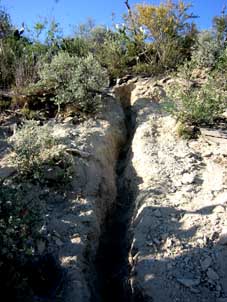 |
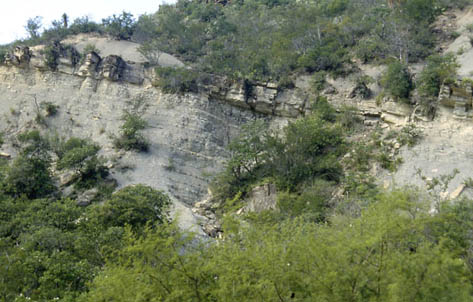 |
| Deep trench at el Penon dug by Keller and her crew to reach bedrock. It is clear that no lateral correlation can be made | The K/T sandstone outcrop of El Mulato, 20 km east of Penon. Outcrops of Maastrichtian Mendez marls underneath the sandstone, and Danian Velasco marls above the sandstone are clean, well exposed and not covered with surface rubble. Yet here no additional spherule layers below the sandstone were found. In fact, in none of the well exposed outcrops in eastern Mexico were they found. |
 |
Here and elsewhere in the paper Keller refers to a "micritic limestone" in the 50 cm interval. In all thin sections examined under backscatter SEM, it is clear that the bulk of the sediment is dolomite, and that calcite only occurs as single crystal sparitic pore-space filling.See below. This term is threrefore wrongly used. |
 |
I
fail to see why a cross-bedded and laminated deposit, with several microcongomerate
lenses that contain breccia clasts and faunal elements of different ages
(see Arz et al 2004) would be incompatible with these premisses. |
 |
|
 |
 |
The textbook definition of the term limestone is clear: At least 50% of the rock should be composed of calcium carbonate (CaCO3). After backscatter SEM examination of thin sections it is clear than the 50 cm interval does NOT consist for >50% of CaCO3, by (Ca, Mg)CO3, dolomite. Micrite is "an aggregate of CaCO3 crystals less than 4 microns in size". If the images are properly emlarged, it becomes clear that all the CaCO3 present is a sparitic pore-space filling, much larger than 4 micron. Therefore, neither the term 'micrite', not the term 'limestone' as user by Keller is correct |
 |
|
 |
|
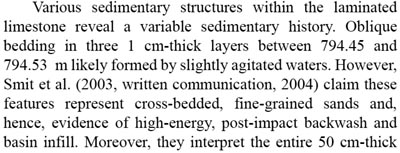 |
|
For some Keller and Stinnesbeck think I have identified these images below as foraminiferal peudomorphs, instead of them. What I said is different: Figure n : SEM backscatter graph of
corroded dolomite rhombs (sample 319), which might resemble foraminiferal
test, and: (fig n shows a SEM backscatter graph of such crystals, strongly
corroded). |
The
very existence of these foraminifera has been questioned by Smit (2004a,
2004b; Smit et al. 2004) who claims that these images are demonstrably
misidentified dolomite rhombs posing for foraminiferal chambers Smit (l994b).
It can easily be demonstrated that the dolomite rhombs Smit considers
as imposters or pseudomorphs of foraminiferal species (see Smit 2004a)
are not foraminifera, and that the foraminifera illustrated in Figs. 11,
12 are not dolomite rhombs. In Fig. 11 we show four species images
in two dimensions from thin sections of the Yax-1 core and compare each
with the pristine 3D image of the same species. In each of the Yax-1 2D
and pristine 3D images the number of chambers, chamber arrangement and
overall morphology are essentially the same and can be clearly identified
as the same species. There is clearly no comparison of these images with
the dolomite rhombs that Jan Smit claims are posing for foraminifera.
The fact that these late Maastrichtian zone CF1 assemblages are present
in the 50 cm interval between the top of the impact breccia and the
K-T boundary indicates that the Chicxulub impact predates the K-T mass
extinction by about 300,000 years |
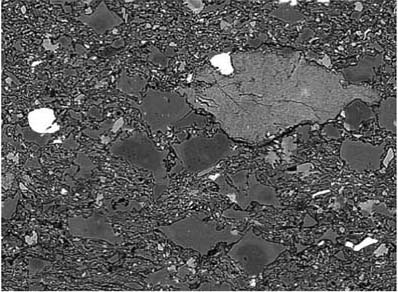 |
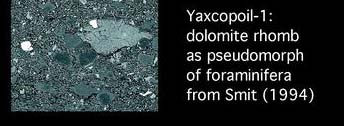 |
|
Fig. 11. Thin ection
micrograph of Yax-1 dolomite rhomb by Jan Smit who claims that the planktic
foraminifera shown in Figs. 10 and 12 are really dolomite rhombs that
have been mistaken for foramifera. Note that there are no similarities
between the foraminifera and the dolomite rhombs, which are much smaller
in size, lack the overall morphology of foraminifera, and do not show
the number and shape of chambers, orderly chamber arrangements, coiling
direction, and apertures. |
Fig. 11 Thin section images of Yax-1 foraminifera in 2D compared with pristine 3D images of the same species taken from the El Kef section of Tunisia. Note that the number and shape of chambers, the chamber arrangement and the overall morphology of the Yax-1 images are the same as for the pristine species and clearly show that they are foraminifera and not dolomite rhombs (shown at the bottom) as claimed by Jan Smit 2004a, 2004b; Smit et al. 2004. The species are from top to bottom: Globotruncana insignis, Rugoglobigerina rugosa, R. macrocephala, Plummerita hantkeninoides |
| Both Keller et al and Stinnesbeck et al use frequently the term laminated micritic limestone for the interval 794.6-794.11m. However, the rock is neither a micrite (see below), nor a limestone. Only one half is laminated (794.39-794.19), the other half (794.6-794.39m) is clearly cross-bedded, with fine climbing ripples at some intervals. | |
|
definition taken |
Micrite In its broadest
sense, an aggregate of CaCO3 crystals less than 4 microns in size. However,
the meaning of this term has varied remarkably since it first appeared in
a publication in 1959, and its use has been the subject of vigorous debate.
Robert L. Folk defined "micrite" as a rock "with microcrystalline ooze matrix" (Folk, 1959, p. 17) and stated that "Type III limestones, almost entirely ooze, are designated simply as 'micrite' . . ." (Folk, 1959, p. 17). He emphasized that "'micrite' should be reserved strictly for those rocks that, under the petrographic microscope, are seen to consist almost entirely of microcrystalline calcite" (Folk, 1959, p. 26). Throughout his 1959 paper, Folk consistently used "micrite" as a rock name and used "ooze" or other terms to refer to sediments, particles of sediments, and particles of limestones. Despite Folk's clear definition of "micrite" as a rock name in 1959, his use of the term had changed slightly by 1962. The third section of Folk's 1962 paper had the heading "Microcrystalline calcite ooze (Micrite)" and said that "The term 'micrite' was introduced as a contraction of 'microcrystalline calcite,' to serve (1) in referring to the matrix of microcrystalline calcite as a rock constituent (for example, brachiopods in a micrite matrix), (2) as a combining term in the calssification of carbonates (for example, 'biomicrite'), and (3) to serve alone as the designation for a rock made up almost entirely of microcrystalline calcite." He also stated that "'Micrite' refers only to clay-sized carbonate". Thus Folk's 1962 paper used the term both explicitly for rocks and at least implicitly for sediments, although Folk continued to use "ooze" when he referred to sediments, and he used "micrite" in his widely reproduced charts of rock names. Subsequent authors have followed Folk's (1962) incipient and indefinite use of "micrite" as a sediment name for the fine-grained matrix of limey sediments and of limestones. This usage was so engrained that Bathurst (1975) defined "micrite" as "an abbreviation of 'microcrystalline ooze' . . . . ; forms crystals 1-4 microns in diameter (Folk, 1959, p. 7-8)", when in fact the word "micrite" did not appear at all on pages 7 or 8 of Folk's 1959 paper and didn't appear until page 17, as noted above. In a dispute about the meaning of "micrite", Milliman et al. (1985) likewise stated that "As originally defined, micrite referred to "microcrystalline carbonate ooze" (Folk, 1959, p. 8)", but the word "micrite" did not appear at all on page 8 of Folk's 1959 paper. These authors correctly stated that "micrite" was a contraction, but their definitions and/or derivations left out the "calcite" that Folk (1962) explcitly said was the source of the "ite" syllable, perhaps because carbonate sedimentologists realized by the 1970s that aragonite, rather than calcite, is the dominant mineral in shallow-water muddy carbonate sediments. Folk's 1959 definition was sufficiently forgotten by the 1990s that Carozzi (1993) wrote that "carbonate mud was originally defined as formed by grains of microcrystalline calcite with a grain size of less than 4 microns and designated by the term micrite (Folk, 1962)". Rezak and Lavoie (1993) likewise stated that micrite "consists of grains 1 to 4 microns in diameter" and noted that "carbonate mud and micrite have been used interchangeably" since 1962. Seemingly the only persons today who remember that "micrite" is a rock name are undergraduate students taught to use Folk's classification of carbonate rocks. By the 1980's, terms like "micrite cement" and "micrite envelope" were common (for example, see Milliman et al., 1985), so that "micrite" became a textural term used to describe microcrystalline components of sediments and/or rocks. In keeping with this expansion of meaning, Jones and Kahle (1995) defined micrite as "calcite particles less than 4 microns long . . . As such, it includes particles that formed as a sediment by precipitation, as a cement, and by the breakdown of pre-existing components". The definition by Jones and Kahle was unusual only because its last few words included the products of terrestrial weathering, whereas micrite had previously almost always been associated with marine sediments. Jones and Motyka (1987) likewise reported on micrite in stalactites. To summarize, "micrite" has evolved from a name for fine-grained limestone (1959) to a name for fine-grained generally marine calcium carbonate sediment (1962-1970s) to a name for finely crystalline components of carbonate sediments and limestones (1970s-1980s) to a name for finely crystalline calcium carbonate of almost any sort (1980s-1990s). In light of the many different meanings of "micrite" and the exclusion of spelean material from most of those meanings, the use of "micrite" for material in speleothems seems likely to cause more confusion than communication, and microcrystalline calcite is suggested as a more descriptive alternative. |